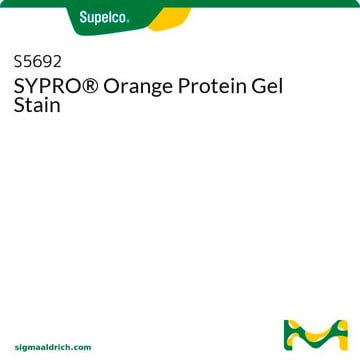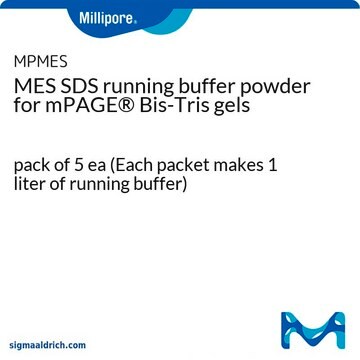S4942
SYPRO® Ruby Protein Gel Stain
Synonym(s):
SYPRO® dye, protein gel stain
Sign Into View Organizational & Contract Pricing
All Photos(1)
About This Item
UNSPSC Code:
41105322
NACRES:
NA.32
Recommended Products
shelf life
≥6 mo. (when stored at room temperature and protected from light)
Quality Level
technique(s)
protein staining: suitable
fluorescence
λex 280,450 nm; λem 610 nm
General description
SYPRO Ruby protein gel stain is a ready-to-use, ultrasensitive, luminescent stain for the detection of proteins separated by polyacrylamide gel electrophoresis (PAGE). This stain, designed especially for use in 2-D PAGE, has proven to be an excellent choice for 1-D PAGE and isoelectric focusing (IEF) gels as well. SYPRO Ruby protein gel stain attains sensitivity comparable to many silver stain techniques. However, unlike silver staining, the SYPRO Ruby gel stain:
- uses a simple staining protocol, with no possibility of overstaining
- delivers a linear quantitation range of over three orders of magnitude
- shows less protein-to-protein variability
- stains glycoproteins, lipoproteins, calcium-binding proteins, fibrillar proteins, and other difficult-to-stain proteins
- will not stain extraneous nucleic acids
- does not interfere with subsequent analysis of proteins by Edman-based sequencing or mass spectrometry
Application
SYPRO ruby protein gel stain has been used for staining of the proteins after sodium dodecyl sulfate–polyacrylamide gel electrophoresis (SDS-PAGE).
Caution
Protect from light.
Legal Information
SYPRO is a registered trademark of Life Technologies
Storage Class Code
10 - Combustible liquids
WGK
WGK 3
Flash Point(F)
Not applicable
Flash Point(C)
Not applicable
Personal Protective Equipment
dust mask type N95 (US), Eyeshields, Gloves
Choose from one of the most recent versions:
Already Own This Product?
Find documentation for the products that you have recently purchased in the Document Library.
Silicatein-mediated incorporation of titanium into spicules from the demosponge Suberites domuncula.
Filipe Natalio et al.
Cell and tissue research, 339(2), 429-436 (2009-12-17)
Primmorphs (a three-dimensional sponge primary cell culture system) have been revealed to be a cell/tissue nano-factory for the production of tailor-made hybrid nanostructures. Growth of primmorphs is stimulated by the presence of a titanium alkoxide precursor tolerating titania (TiO2) concentrations
Chronic hypoxia alters mitochondrial composition in human macrophages.
Fuhrmann DC, et al.
Biochimica et Biophysica Acta, 1834, 2750-2760 (2013)
Mario Navarrete et al.
Clinical proteomics, 10(1), 17-17 (2013-11-19)
Serine hydrolases constitute a large enzyme family involved in a diversity of proteolytic and metabolic processes which are essential for many aspects of normal physiology. The roles of serine hydrolases in renal function are largely unknown and monitoring their activity
Christoph Schröder et al.
Methods in molecular biology (Clifton, N.J.), 785, 203-221 (2011-09-09)
Antibody microarrays are a multiplexing technique for the analyses of hundreds of different analytes in parallel from small sample volumes of few microlitres only. With sensitivities in the picomolar to femtomolar range, they are gaining importance in proteomic analyses. These
Jun Zou et al.
eLife, 4, e09406-e09406 (2015-10-17)
Truncating mutations in the giant sarcomeric protein Titin result in dilated cardiomyopathy and skeletal myopathy. The most severely affected dilated cardiomyopathy patients harbor Titin truncations in the C-terminal two-thirds of the protein, suggesting that mutation position might influence disease mechanism.
Our team of scientists has experience in all areas of research including Life Science, Material Science, Chemical Synthesis, Chromatography, Analytical and many others.
Contact Technical Service







